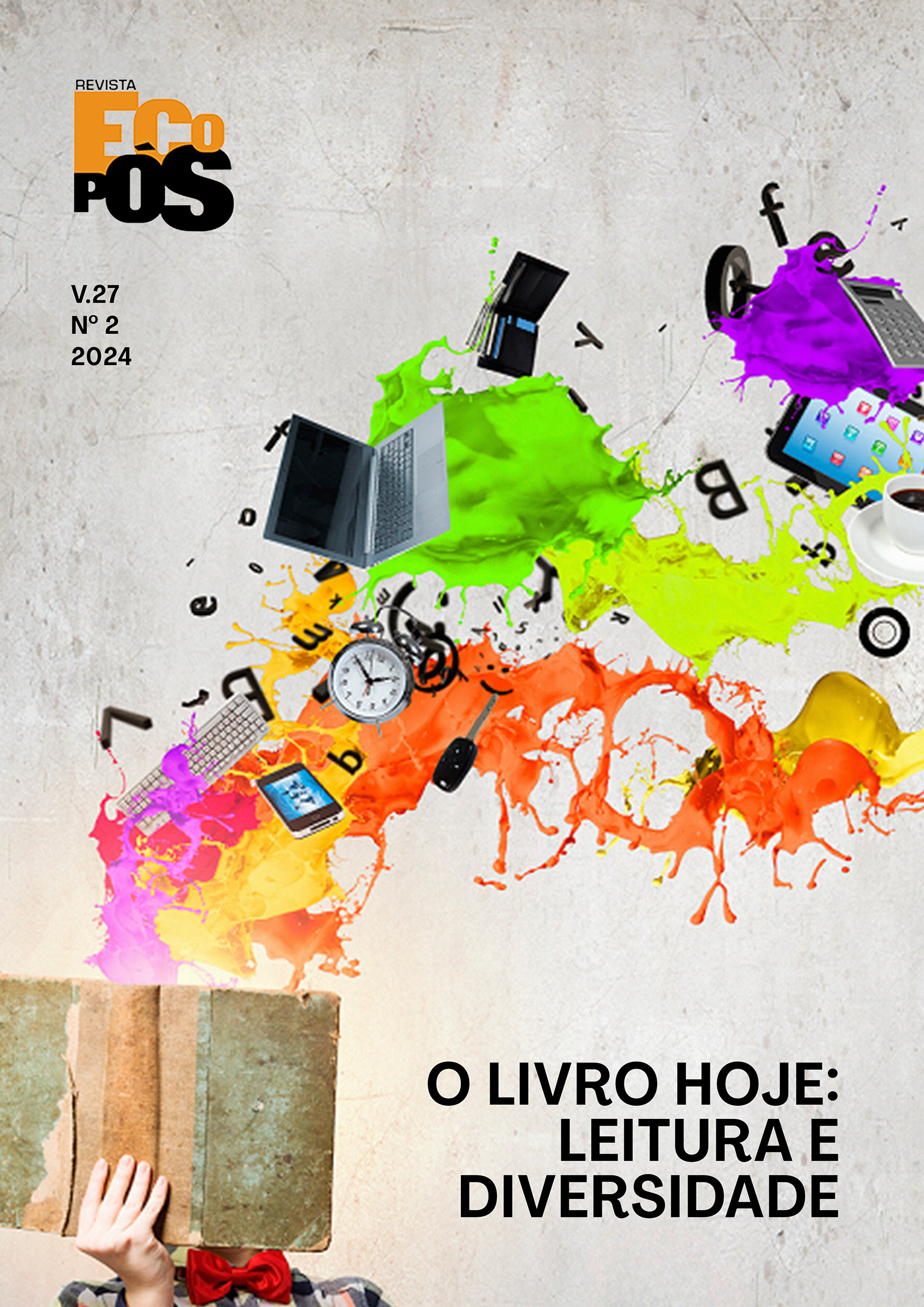The semiotics of irony in videogames
Relating verbal, visual, and procedural signs in the creation of an absurd enunciator
DOI:
https://doi.org/10.29146/eco-ps.v27i2.28070Keywords:
irony, verbal irony, visual irony, procedurality, videogamesAbstract
This article proposes an analytical model from which irony, a concept here initially considered in its traditional configuration as “verbal irony” and subsequently expanded to “semiotic irony,” could be employed as a formal analytical tool for videogame poetics. Regarding verbal and/or visual irony, the theoretical framework provided by Ducrot (1987), Brait (2008), and Scott (2004) is adopted, whereas Bogost (2007, 2008) informs the theoretical framework on procedurality as a compositional element specific to games. A method for analyzing irony in videogames is then suggested which takes into account the articulation between the three languages here identified as most significant to their composition: verbal, (audio)visual, and procedural. Then, the proposed method is tested against the concrete case provided by the videogame Orgasm simulator (Molleindustria, 2003). We were able to conclude that irony in videogames is constructed and encoded by the combination of varied semiotic systems, and that their specific procedural language is also capable of creating ironic meaning.
Downloads
References
AARSETH, Espen. Cybertext: perspectives on ergodic literature. Baltimore: The Johns Hopkins University Press, 1997.
BOGOST, Ian. Persuasive games: the expressive power of videogames. Cambridge: The MIT Press, 2007.
BOGOST, Ian. The rhetoric of video games. In: SALEN, Katie (Ed.). The ecology of games: connecting youth, games, and learning. Cambridge: The MIT Press, 2008. p. 117-140.
BRAIT, Beth. Ironia em perspectiva polifônica. 2. ed. Campinas: Editora da Unicamp, 2008.
CARVALHO, Amorim de. Tratado de versificação portuguesa. Lisboa: Universitária, 1987.
CASELLI, Stefano; GIAPPONE, Krista Bonello Rutter; SCHELLEKENS, Jasper; GUALENI, Stefano. Satire at play: a game studies approach to satire. In: International Conference on the Foundations of Digital Games, 15., 2020, Bugibba, Malta. Proceedings […]. Nova Iorque: ACM, 4p. Disponível em: https://doi.org/10.1145/3402942.3403007. Acesso em: 02 maio 2024.
DUCROT, Oswald. O dizer e o dito. Tradução de Eduardo Guimarães. Campinas: Pontes, 1987.
ESTRELA. Manual de instruções Banco Imobiliário Brasil. São Paulo: Estrela, [s. d.]. Manual de instruções de jogo de tabuleiro. Disponível em: https://www.estrela.com.br/central-de-manuais. Acesso em: 05 maio 2023.
FRASCA, Gonzalo. Videogames of the oppressed: videogames as a means for critical thinking and debate. Dissertação (Mestrado em Information Design and Technology) – School of Literature, Communication and Culture, Georgia Institute of Technology. Georgia, 118 p., 2001.
FOSS, Sonja K. Theory of visual rhetoric. In: SMITH, Ken; MORIARTY, Sandra; BARBATSIS, Gretchen; KENNEY, Keith (Eds.). Handbook of visual communication: theory, methods, and media. Mahwah: Lawrence Arlbaum Associates, 2005. p. 141-152.
HUTCHEON, Linda. Teoria e política da ironia. Belo Horizonte: UFMG, 2000.
JUUL, Jesper. Half-real: videogames entre regras reais e mundos ficcionais. Tradução de Alan Richard da Luz. São Paulo: Blucher, 2019.
MACHADO, Ida Lucia. Irony as a communicative and argumentative strategy. Bakhtiniana, São Paulo, v. 9, n. 1, p. 118-137, jan./jul. 2014.
MOLLEINDUSTRIA. Orgasm simulator. [S. l.]: Molleindustria, 2003. jogo eletrônico. Disponível para download em: https://www.molleindustria.org/en/orgasm-simulator/. Acesso em: 05 maio 2023.
MURRAY, Janet H. Hamlet no holodeck: o futuro da narrativa no ciberespaço. Tradução de Elissa Khoury Daher e Marcelo Fernandez Cuzziol. São Paulo: Itaú Cultural: Editora Unesp, 2003.
SAUSSURE, Ferdinand de. Curso de linguística geral. Tradução de Antônio Chelini, José Paulo Paes e Izidoro Blikstein. 28. ed. São Paulo: Cultrix, 2012.
SCHELLEKENS, Jasper; CASELLI, Stefano; GUALENI, Stefano; GIAPPONE, Krista Bonello Rutter. Satirical game design: the case of the boardgame Construction BOOM! In: International Conference on the Foundations of Digital Games, 15., 2020, Bugibba, Malta. Proceedings […]. Nova Iorque: ACM, 12 p. Disponível em: https://doi.org/10.1145/3402942.3403008. Acesso em: 02 maio. 2024.
SCOTT, Biljana. Picturing irony: the subversive power of photography. Visual Communication, v. 3, n. 1, p. 31-59, 2004. Disponível em: https://doi.org/10.1177/1470357204039597. Acesso em: 05 maio. 2023.
SICART, Miguel. Against procedurality. Game Studies, v. 11, n. 3, 2011. Disponível em: http://gamestudies.org/1103/articles/sicart_ap. Acesso em: 05 maio 2023.
Downloads
Published
How to Cite
Issue
Section
License
Copyright (c) 2024 Natalia Corbello, Márcio Prado

This work is licensed under a Creative Commons Attribution-NonCommercial-NoDerivatives 4.0 International License.
Aos autores pertence o direito exclusivo de utilização ou reprodução.
Você tem o direito de:
- Compartilhar — copie e redistribua o material em qualquer meio ou formato.
- Adaptar — remixar, transformar e construir sobre o material para qualquer filme, mesmo comercial.
O licenciante não pode revogar esses direitos, desde que você respeite os termos da licença.
De acordo com os seguintes termos:
- Atribuição — Você deve dar o devido crédito, fornecer um link para a licença e indicar se essas alterações foram feitas. Você pode fazê-lo de qualquer maneira razoável, mas não de maneira que sugira que o licenciante endosse ou aprove seu uso.
- Sem restrições adicionais — Você não pode aplicar termos legais ou medidas de natureza tecnológica que restrinjam legalmente outros de fazer algo que a licença permite.
Aviso: A licença pode não fornecer todas as permissões necessárias para o uso pretendido. Por exemplo, outros direitos, como publicidade, privacidade ou direitos morais, podem limitar a maneira como você usa o material.











